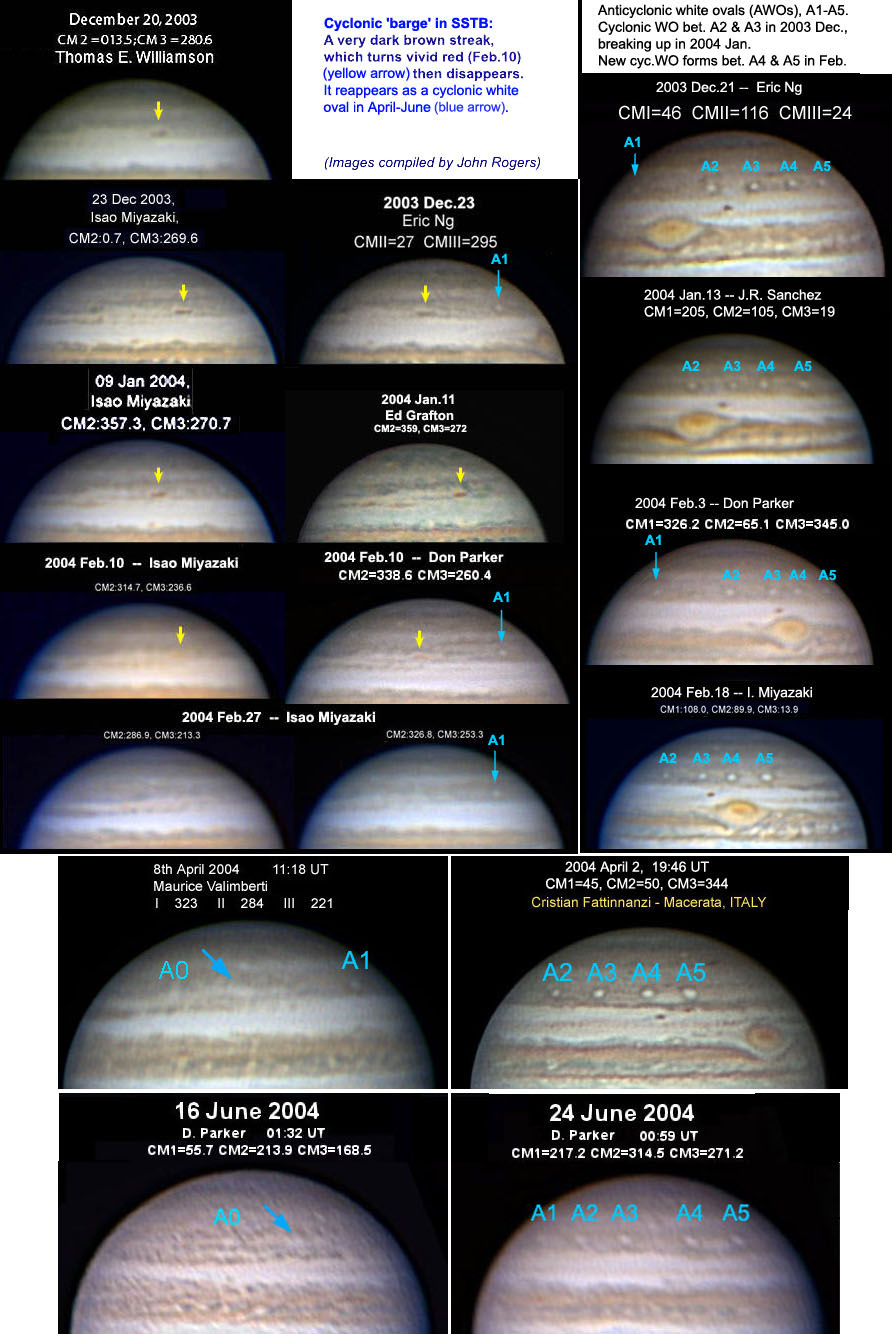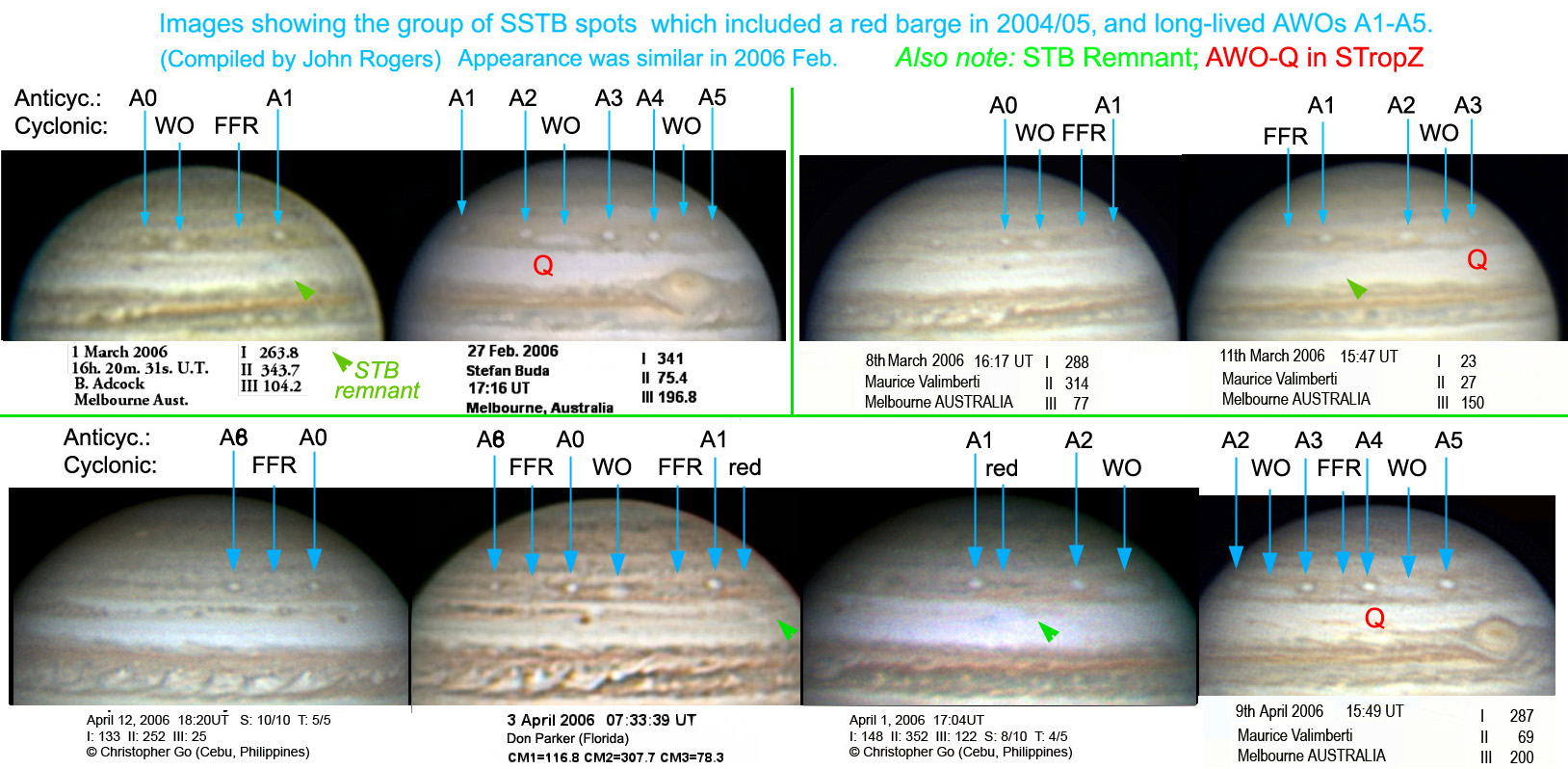| Jupiter's SSTB ovals by John H. Rogers |
Long-lived circulations in the S.S. Temperate domain
This bulletin reviews the history of the circulations in the S.S. Temperate
domain over the last few years. Attached is a composite of JUPOS charts
(prepared by Hans-Joerg Mettig and colleagues), and three montages of
high-resolution images from 2004, 2005, and 2006, showing these long-lived
spots.
The first group of interest comprises the set of five anticyclonic white
ovals (AWOs), named A1 to A5. Initially there were seven, but A6 and A7
merged in 2002 March, and the product probably merged with A5 in turn during
the following solar conjunction, so there have been five AWOs since 2003.
[In the S.S. Temp. domain, the number of S.S.Temp. AWOs has remained
constant at 6-7 since 1986, in spite of several appearances and
disappearances and mergers. This is noted in our paper on the mergers of
ovals, submitted to 'Icarus'.]
A question of theoretical interest is whether they are separated by cyclonic
circulations. These can be of several types: white ovals (WO), dark streaks
or barges, red-brown barges, and 'folded filamentary regions' (FFRs). FFRs
are turbulent chaotic circulations with thunderstorms, according to
spacecraft imagery, but are difficult to detect from Earth because at low
resolution they have low contrast. So where ground-based images suggest
subtle grey streaks or spots, there may be a FFR.
The most conspicuous cyclonic circulations in this cluster are long white
ovals between A2-A3 and between A4-A5. There were already cyclonic white
ovals in these locations in 2002/03 [see images of the GRS in 2003 Jan., not
included here], though the one between A4-A5 was invisible in late 2003; and
the one between A2-A3 broke up in 2004 Jan. Then the WO re-formed between
A4-A5 in 2004 Feb. From then until 2005 April it grew progressively longer,
from ~10 deg. to ~20 deg. long; this is typical of elongated cyclonic
circulations (such as historic STB Fades: Rogers, 1995). In 2005-2006 its
length has fluctuated slightly.
Meanwhile the WO between A2-A3 reappeared in early 2005 and likewise grew
progressively longer, from ~11 deg. then to ~20 deg. now.
The second interesting cluster of spots precedes the AWOs, and includes at
least one strikingly variable cyclonic circulation. This was a very dark
brown streak or 'barge' from 2003 Nov. to 2004 Jan. Then it turned vivid
red (2004 Feb.10) and disappeared (late Feb.) - reappearing as a bright
white oval in June. This behaviour strongly resembled that of a similar
cyclonic circulation in the STB from 1994 to 1998, which we called the
'Morphing Spot' [see BAA reports; the report for 1994, by Mike Foulkes and
J.R., is still unpublished]. The STB Morphing Spot was preceding AWO FA.
The SSTB morphing spot in 2004 was f. a newly forming AWO, which we here
call A0.
In 2004/05, A0 and the resulting cyclonic WO still existed, and another spot
pair formed immediately f. them: a small AWO, and a dark streak ('barge')
which turned red-brown as it passed oval BA in 2005 Jan. These are no
longer present in 2006.
Further v-hi-res images will be of interest. One aim is to see whether
there are FFRs between other pairs of AWOs. Recent v-hi-res images do seem
to show FFRs p. AWOs A0, A1, and A4, although these identifications are
inevitably tentative. It has never before been possible to resolve these
circulations adequately from Earth. Another aim is to document the
transformations between different forms more consistently than before. Apart
from the changes we have seen in 'morphing spots', we also know from Voyager
movies that SSTB-WOs can turn into FFRs suddenly, so amateur imagers now
have the opportunity to follow such events. Finally, we need to determine
the complete life cycle of the AWOs, which used to be difficult for amateurs
to detect at all, but are now striking landmarks on many of your images.
John Rogers,
2006 April 13.
SSTB-set_2004

SSTB-set_2005

SSTB-set_2006

SSTC_2003-06
 John H. Rogers : Jupiter Section Director,
[British Astronomical Association.]
John H. Rogers : Jupiter Section Director,
[British Astronomical Association.]Goto English
Japanese
●SSTBドメインの長命な循環 この報告では、ここ数年の木星のSSTBドメインの歴史および循環をレビューする。添付ファイルは、JUPOSチャート(Hans-Joerg Mettigと協力者が作成)の合成と、これらの長命な斑点を示す2004年、2005年、2006年の高解像度画像の3つのモンタージュである。
興味のある最初のグループは、A1からA5と名付けられた5個の高気圧性の白斑(AWOs)の組を構成する。最初は7個あったが、A6とA7は2002年3月にマージした。そして、そのマージした白斑は、その後の太陽との合の間に、次々とA5とおそらくマージした。それで、2003年からは5個のAWOsが存在している。
理論的な興味の疑問は、それらが低気圧性循環によって分けられているかどうかである。これらには、白斑(WO)、dark streakまたはbarge、赤茶色のbarge、折れたたまれたフィラメント領域(FFRs;folded filamentary regions)の、いくつかのタイプがある。FFRsは、探査機の画像によれば、雷雲を伴った荒れ狂う無秩序な循環のことであるが、低分解能では低いコントラストであるために、地球から検出するのは難しい。したがって、地上での画像で微妙なグレーのストリークあるいは斑点を示すところは、FFRsであるかもしれない。
この集団で最も目立つ低気圧性循環はA2-A3の間とA4-A5の間の長い白斑である。2002/03年にはこれらの位置にすでに低気圧性の白斑が存在しているが(2003年1月のGRSの画像を参照、ここには含まれていない)、A4-A5の間の白斑は2003年の終わりには見えなかったし、A2-A3の間の白斑は2004年1月に分解した。その後、2004年2月にはA4-A5の間に白斑が再形成された。それから2005年4月まで、次第に約10度から約20度まで長く伸びている。これが典型的な引き伸ばされた低気圧性循環である(歴史的なSTB淡化のような;Rogers, 1995)。2005-06年には、その長さはわずかに変動している。一方、A2-A3の間の白斑は2005年初めに再度出現し、同様に約11度から現在の約20度まで次第に長く伸びている。
2番目に興味のある斑点の集合はAWOsの前方にあり、少なくとも1個の目立った変化する低気圧性循環を含んでいる。2003年11月から2004年1月まで、これは非常に暗い茶色のストリークあるいはbargeであった。その後、それは鮮やかな赤に変わり(2004年2月10日)、消失し(2月後半)、6月に1個の明るい白斑として再度出現した。この振る舞いは、1994年から1998年までにSTBにあった同様な、我々が'Morphing Spot(変化する斑点)'と呼んだ [参考BAA reports; the report for 1994, by Mike Foulkes and J.R., 未公開]、低気圧性循環ととても似ている。STB Morphing Spotは高気圧性白斑(AWO)FAの前方にあった。2004年のSSTB Morphing Spotは、新たに形成された高気圧性白斑(ここではA0と呼ぶことにする)の後方にある。
2004/05年には、A0と結果として生じた低気圧性白斑(WO)はなおも存在し、他の斑点の組がそれらの後方に直ちに形成された。それは小さな高気圧性白斑(AWO)とdark streak ('barge')で、2005年1月に白斑BAを追い越した時に赤茶色に変化した。これらは2006年にはもはや存在していない。
さらに超高解像度画像は面白い。一つの目的はAWOの他のペアの間にFFRがあるかどうかということである。最近の超高解像度画像では、それらの同定は必然的にあやふやであるけれども、AWOのA0、A1、A4の前方にFFRがあるように見える。これらの循環を地球から適切に決定することは、以前には決してできなかった。もう一つの目的は、以前よりも矛盾なく、異なった形態間の変換を文書にすることである。我々が'morphing spots'として見た変化とは別に、SSTB WOが突然FFRに変わるというボイジャーの動画のことも知っていて、アマチュアの画像が今やそのような現象を理解するための機会となっている。最後に、AWOの完全なライフサイクルを決定する必要があるが、それはアマチュアにとってまったく難しいものであったけれども、今やあなたの多くの画像に目印が打ち込まれている。
SSTB-set_2004
SSTB-set_2005
SSTB-set_2006
SSTC_2003-06
 John H. Rogers : Jupiter Section Director,
[British Astronomical Association.]
John H. Rogers : Jupiter Section Director,
[British Astronomical Association.]ALPO-Japan Latest
Saturn Section